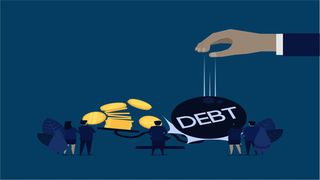
Kenya's debt crisis has been cooking since the Jubilee administration took charge.
| FileBusiness
Premium
Sh7.7 trillion public debt squeezes development budget
The cost of a huge public debt is getting more painful for Kenyans as the government sacrifices development budgets to service loans.
The Controller of Budget’s latest report on the 2020/21 financial year shows that public debt constitutes about 37.7 per cent of Kenya’s recurrent expenditures.
Between July last year and this June, Kenya spent more than Sh765.9 billion to service loans even as the debt level hit Sh7.485 trillion by end of May, according to the National Treasury.
“The total nominal public and publicly guaranteed debt at end of May 2021 was Sh7,485.91 billion (66.4 per cent of GDP). Domestic debt stock was Sh3,686.89 billion- or Sh3.68 trillion (32.7 per cent of GDP) while the External debt stock was Sh3.799 trillion (33.7 per cent of GDP). Domestic debt accounted for 49 per cent of total debt while external debt accounted for 51 per cent,” states the Treasury report on public debt.
The Central Bank of Kenya’s (CBK) latest report shows the total public debt was Sh7.7 trillion by the end of June. Assuming Kenya spent an equal amount to pay public debt daily from July 1 last year to June 30 this year, the total taxpayer money spent was in the upwards of Sh2.09 billion daily.
Sh904.7 billion
During budgeting, the Treasury had estimated to spend Sh904.7 billion, out of which the Exchequer released Sh862.8 billion. Out of the amount released, Sh765.9 billion (or 90.4 per cent of the net estimates), was spent on servicing loans.
The amount outweighs what the country spent to support development programmes for 10 critical sectors in the economy, including health, education, agriculture and energy by over Sh200 billion, or 36.4 per cent.
Kenya spent a total of Sh561,521,690,504 as sectoral development expenditure for agriculture, rural and urban Development (Sh18.37 billion), energy, infrastructure and ICT (Sh277.9 billion), general economics and commercial affairs Sh8.8 billion) and health (Sh39.8 billion).
About Sh15.8 billion was spent on education, national security (Sh9.67 billion), social protection, culture and recreation (Sh13.6 billion) and environmental protection, water and natural resources (Sh37.9 billion).
Recurrent expenditure for the 10 sectors during the year, however, was Sh1.15 trillion.
Between July last year and June this year, the national government spent Sh2.03 trillion as recurrent expenditure, following Sh2.04 trillion that the Exchequer issued. Out of this, the Sh765.9 billion was spent on public debt, which constituted about 37.7 per cent.
The COB report shows public debt is the single highest expenditure by the government, followed by payment of salaries to teachers, through gross recurrent expenditure by the Teachers Service Commission (TSC) of Sh274,881,135,958.
The report has exposed how vulnerable the economy is getting as public debt eats deeper into the national cake. As the government increases its borrowing appetite, the loans continue to stifle the budget.
This financial year’s Sh3.6 trillion budget is estimated to have a fiscal deficit of at least 7.5 per cent, meaning the government will be borrowing about Sh1 trillion more to add onto the current debt.





